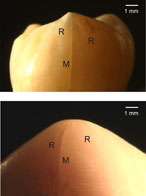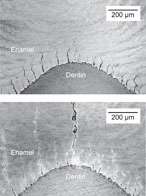Researchers Crack the Mystery of Resilient Teeth

(PhysOrg.com) -- After years of biting and chewing, how are human teeth able to remain intact and functional? A team of researchers from The George Washington University and other international scholars have discovered several features in enamel--the outermost tooth tissue--that contribute to the resiliency of human teeth.
Human enamel is brittle. Like glass, it cracks easily; but unlike glass, enamel is able to contain cracks and remain intact for most individuals' lifetimes. The research team discovered that the major reason why teeth do not break apart is due to the presence of tufts--small, crack-like defects found deep in the enamel.
Tufts arise during tooth development, and all human teeth contain multiple tufts before the tooth has even erupted into the mouth. Many cracks in teeth do not start at the outer surface of the tooth, as has always been assumed. Instead cracks arise from tufts located deep inside the enamel.
From here, cracks can grow towards the outer tooth surface. Once reaching the surface, these cracks can potentially act as sites for dental decay. Acting together like a forest of small flaws, tufts suppress the growth of these cracks by distributing the stress amongst themselves.

"This is the first time that enigmatic developmental features, such as enamel tufts, have been shown to have any significance in tooth function," said GW researcher Paul Constantino. "Crack growth is also hampered by the "basket weave" microstructure of enamel, and by a 'self-healing' process whereby organic material fills cracks extended from the tufts, which themselves also become closed by organic matter. This type of infilling bonds the opposing crack walls, which increases the amount of force required to extend the crack later on."
This research evolved as part of an interdisciplinary collaboration between anthropologists from The George Washington University and physical scientists from the National Institute of Standards and Technology in Gaithersburg, Md. The team studied tooth enamel in humans and also sea otters, mammals with teeth showing remarkable resemblances to those of humans.
The article, "Remarkable resilience of teeth" appears in the April 2009 edition of Proceedings of the National Academy of Sciences.
Provided by George Washington University














